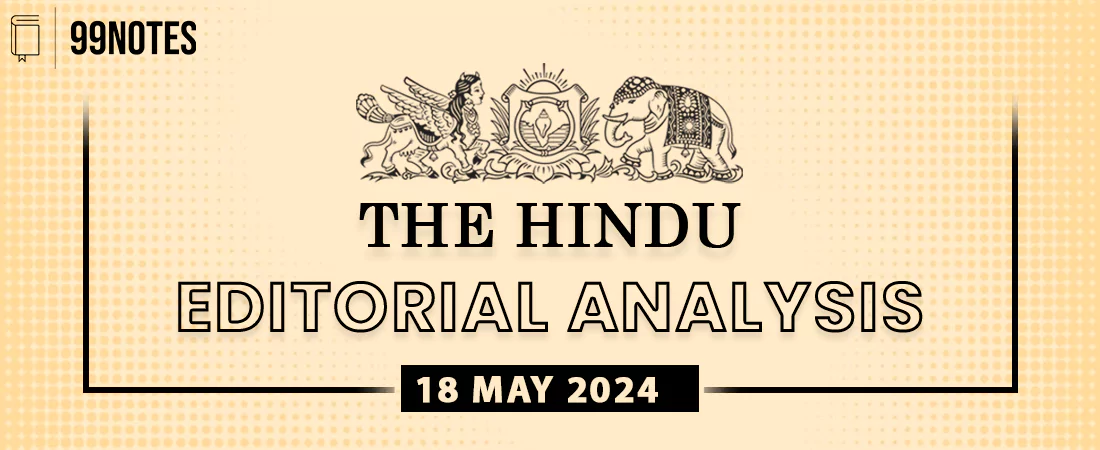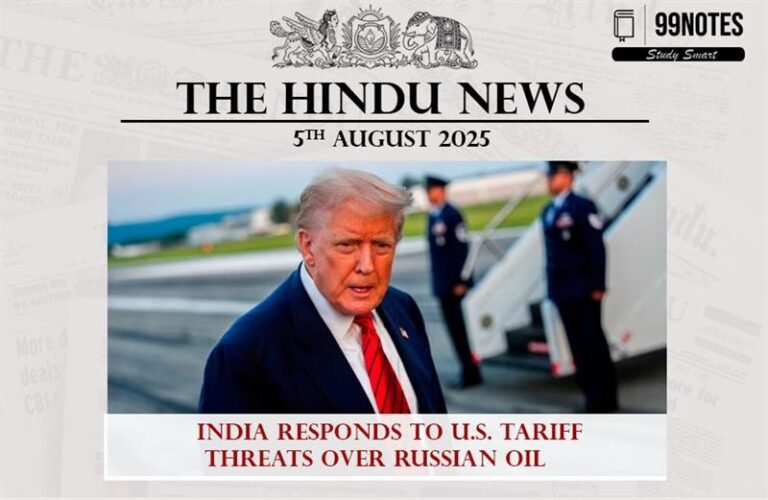18 May 2024 : The Hindu Editorial Notes PDF
1. The hyperpoliticisation of Indian higher education
| Topic: GS2 – Social Justice – Education |
| Context |
| ● The article discusses the politicisation of Indian higher education, highlighting historical trends and contemporary challenges.
● It outlines instances of political interference in academic appointments, attacks on academic freedom, and student involvement in campus politics. ● The erosion of academic autonomy poses risks to intellectual life and India’s aspirations for global academic recognition. |
Historical Context:
- The politicisation of Indian higher education has raised concerns about academic freedom and autonomy.
- This trend, marked by politically motivated appointments, self-censorship, and student involvement in campus politics, poses significant risks to intellectual life and India’s aspirations for global academic recognition.
Historical Context:
- Politicians historically established colleges and universities to bolster support and advance their careers.
- Institutions were often strategically located to cater to socio-cultural demands and electoral needs.
Naming and Renaming of Higher Education Institutions by State governments:
- Universities’ names and renaming processes, particularly by State governments, are influenced by political agendas.
- Such decisions are often made to align with prevailing political sentiments or to appease specific interest groups.
Academic Appointments and Freedom:
- Academic appointments and promotions sometimes prioritise political allegiance over professional merit.
- Despite occasional interference and bureaucratic hurdles, Indian universities generally adhere to international norms of academic freedom.
- Indian higher education has undergone a fundamental politicisation, posing risks to academic institutions and intellectual life.
- These trends align with broader societal illiberal shifts, and India risks repercussions on the global academic stage.
Examples of Politicisation:
- Recent criticisms against politically appointed vice-chancellors underscore the pervasive influence of political agendas.
- The Bharatiya Janata Party (BJP) has replaced university officials with politically aligned appointees, disrupting institutional autonomy.
Attacks on Academic Freedom:
- Instances of self-censorship among senior academics are prevalent, particularly in sensitive disciplines like social sciences and humanities.
- Renowned professors have faced repercussions for publishing controversial material, highlighting threats to academic autonomy.
Challenges to Independence:
- Respected academic journals have faced pressure, impacting their editorial independence and scholarly integrity.
- Faculty members, including prominent scholars, have encountered online smear campaigns and legal threats for expressing dissenting views.
Student Involvement and Campus Politics:
- Right-wing student organisations have gained prominence, influencing campus dynamics even at traditionally leftist universities.
- Students report faculty members to administrators for ideological disagreements, leading to disciplinary actions.
Implications for Higher Education and Civic Life:
- The erosion of academic freedom threatens the integrity and independence of higher education institutions.
- An environment conducive to unfettered research and scholarly expression is crucial for societal progress and intellectual growth.
- Safeguarding academic autonomy is vital for India’s aspirations to establish world-class universities and engage with global academic networks.
| Potential impacts of politicisation of Higher Education: |
| Potential Impact of Politicisation of Higher Education:
● Undermining Academic Integrity: Politicisation can compromise academic freedom, leading to biased research, censorship, and ideological indoctrination. ● Quality of Education: Prioritising political agendas over academic merit can degrade the quality of education, research, and teaching standards. ● Polarisation: Politicisation can exacerbate polarisation among students, faculty, and administrators, fostering a divisive and hostile academic environment. ● Erosion of Trust: Perceived politicisation erodes public trust in higher education institutions, undermining their credibility and legitimacy. ● Brain Drain: Political interference may drive talented scholars, researchers, and students away, resulting in brain drain and loss of intellectual capital. ● Impact on Innovation: Political pressures can stifle innovation, creativity, and critical thinking, hindering progress and advancement in academic fields. Way Forward to Address Politicisation of Higher Education: ● Autonomy and Governance: Safeguard institutional autonomy and strengthen governance mechanisms to insulate higher education from undue political influence. ● Merit-Based Appointments: Ensure transparent and merit-based processes for appointing faculty, administrators, and governing bodies to uphold academic standards. ● Promote Diversity: Foster diversity of perspectives, ideologies, and disciplines within higher education institutions to encourage open debate and intellectual exchange. ● Ethical Guidelines: Implement and enforce ethical guidelines and codes of conduct to uphold academic integrity and prevent politicisation. ● Dialogue and Engagement: Foster constructive dialogue and engagement among stakeholders, including students, faculty, administrators, policymakers, and civil society, to address concerns and promote consensus on academic matters. ● Public Awareness: Raise public awareness about the importance of academic freedom, institutional autonomy, and the dangers of politicisation to garner support for safeguarding higher education. |
| PYQ: How have digital initiatives in India contributed to the functioning of the educational system in the country? Elaborate your answer. (250 words/15m) (UPSC CSE (M) GS-1 2020) |
| Practice Question: How has the politicisation of Indian higher education affected academic freedom and autonomy? Discuss the implications of this trend on intellectual life and India’s pursuit of global academic recognition. (150 Words /10 marks) |
2. India should not tailor its ties with Iran to U.S. foreign policy changes
| Topic: GS2 – International Relations |
| Context |
| ● Despite tensions in West Asia, India signs a 10-year agreement with Iran to develop and operate the Chabahar port, investing $120 million and offering a $250 million credit facility.
● This move aims to enhance connectivity to Afghanistan and Central Asia, bypassing Pakistan, and strengthen India’s trade and geopolitical influence in the region. |
India-Iran Chabahar Port Agreement:
Background and Agreement Details:
- India signed a 10-year agreement with Iran to develop and operate the Chabahar port, despite tensions in West Asia.
- The agreement involves an investment of $120 million by India and a credit facility of $250 million to further develop the terminal in Chabahar’s Shahid Beheshti port and related projects.
- Previously, American sanctions on Iran had delayed the project, which was conceived in 2003 but did not take off for years due to sanctions imposed by the U.S. and the UN over Tehran’s nuclear program.
- India signed a memorandum of understanding in 2015 after Washington eased sanctions on Iran following the nuclear agreement, with the contract executed in 2016 during Prime Minister’s Iran visit.
- Despite the U.S.’s unilateral withdrawal from the nuclear deal in 2018 and reimposition of sanctions on Iran, India managed to win a carve-out from U.S. sanctions to operate the port through ad hoc measures.
Strategic Importance of Chabahar Port:
- Chabahar port is crucial for India’s connectivity plans, offering an alternative route to Afghanistan and Central Asia by bypassing Pakistan, thus enhancing trade prospects with Central Asia.
- The port is expected to be connected to the International North-South Transport Corridor (NSTC), facilitating trade between India and Europe through Iran, Azerbaijan, and Russia, reducing time and costs associated with intercontinental trade.
- Positioned roughly 200 km from Pakistan’s Gwadar port, where China is developing a port as part of its Belt and Road Initiative (BRI), Chabahar enables India to expand its geopolitical influence in Central Asia.
U.S. Perspective and Changing Dynamics:
- The U.S. has expressed concerns over entities engaging in business deals with Iran, warning of potential sanctions risks.
- America’s stance on the Chabahar project seems influenced by its hostility towards Iran, with its interests in the region evolving over time.
- In 2018, when U.S. forces supported the Islamic Republic government in Afghanistan, it granted a sanctions waiver to India, recognizing the benefits of the port project for Afghanistan.
- However, with the Taliban replacing the Islamic Republic and U.S. troops withdrawing from Afghanistan, America’s focus has shifted towards containing Iran, potentially impacting its view on the Chabahar project.
India’s Strategic Imperatives:
- India has previously adjusted its engagement with Iran based on policy changes in Washington DC but should now prioritise its long-term interests in Chabahar.
- Staying invested in Chabahar and enhancing trade and connectivity projects with Central Asia are vital for India’s continued economic and strategic growth.
- India’s commitment to Chabahar despite changing geopolitical dynamics reflects its determination to secure alternative trade routes and bolster its regional influence.
| Importance of port for India: |
| ● Strategic Access: Chabahar Port provides India with direct access to Afghanistan and Central Asia, bypassing Pakistan, thus reducing dependence on the volatile Pakistan-Afghanistan route.
● Trade Routes Diversification: It diversifies India’s trade routes, offering an alternative to the congested and politically sensitive Strait of Hormuz and the Gulf of Oman. ● Regional Connectivity: Chabahar Port is a crucial component of India’s efforts to enhance connectivity and promote economic integration with Afghanistan, Central Asia, and beyond. ● Energy Security: Chabahar Port opens avenues for energy cooperation, including access to hydrocarbon resources in Central Asia and the Middle East, enhancing India’s energy security. ● Humanitarian Assistance: It facilitates the delivery of humanitarian aid and reconstruction efforts in Afghanistan, showcasing India’s commitment to regional stability and development |
| PYQ: In what ways would the ongoing US-Iran Nuclear Pact Controversy affect the national interest of India? How should India respond to this situation? (250 words/15m) (UPSC CSE (M) GS-2 2018) |
| Practice Question: Discuss the strategic significance of India’s recent agreement with Iran to develop and operate the Chabahar port in the context of enhancing regional connectivity and geopolitical influence. (250 Words /15 marks) |




